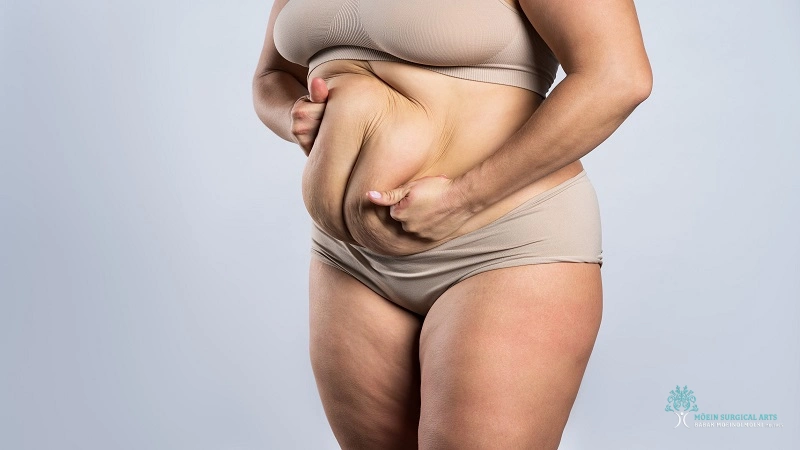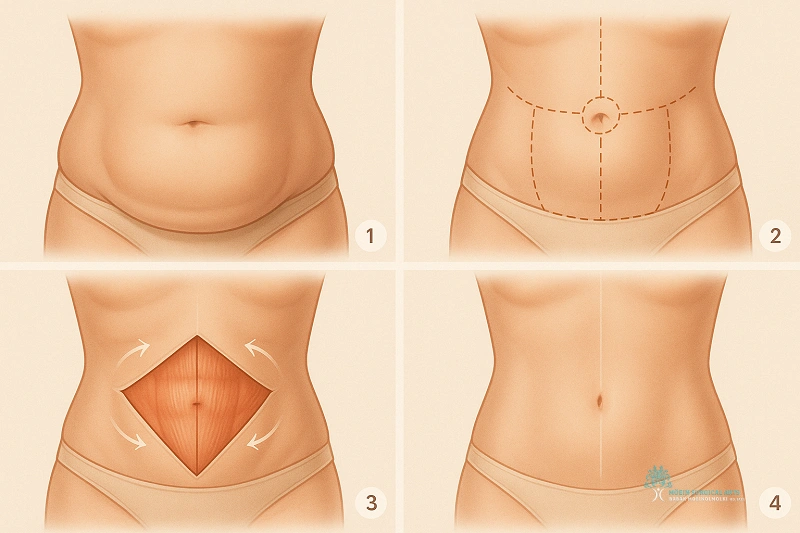
The Fleur-de-Lis Tummy Tuck procedure is one of the most drastic types of plastic surgery, involving the removal of skin both vertically and horizontally to address the laxity of the abdominal skin that cannot be corrected with a standard abdominoplasty. This complex surgical procedure, which is performed by skilled cosmetic surgeons such as Dr. Babak Moein of Moein Surgical Arts in Los Angeles, involves the removal of skin both vertically and horizontally, along with the tightening of the abdominal muscles, to achieve a significantly enhanced aesthetic look for individuals who have undergone massive weight reduction and/or pregnancies. The standard Tummy Tuck procedure only involves the skin that is relaxed horizontally, whereas the Fleur-de-Lis Tummy Tuck procedure involves skin relaxation in both vertical and horizontal directions.

A Fleur-de-Lis Tummy Tuck (sometimes written “Fleur de Lis”) is an advanced form of extended tummy tuck designed to correct excess skin in two planes:
Where a standard tummy tuck in Los Angeles focuses mainly on the lower abdomen and central muscle tightening, the Fleur-de-Lis technique adds a vertical midline incision. This allows the surgeon to remove a “wedge” of excess skin from the center, tightening the waist and upper abdomen in a way that standard abdominoplasty cannot achieve.
Despite its more extensive scars, many patients feel the benefits far outweigh the trade-offs, especially after massive weight loss.
Key advantages include:
For patients considering extended tummy tuck options or multi-area body contouring surgery, the Fleur-de-Lis pattern can be the centerpiece of a transformational plan.

Below is a comparison of the Fleur-de-Lis Tummy Tuck and a Traditional Tummy tuck to help you understand which may be right for you.
| Feature | Fleur-de-Lis Tummy Tuck | Standard Tummy Tuck |
|---|---|---|
| Ideal Candidate | Massive weight loss patients with excess skin both vertically and horizontally | Patients with moderate skin laxity mainly in the lower abdomen |
| Incision Pattern | Horizontal bikini-line incision + vertical midline incision | Horizontal bikini-line incision only |
| Skin Removed | Removes skin in both vertical and horizontal directions; trims waist and central abdomen | Removes mostly lower abdominal skin and some upper abdominal laxity |
| Effect on Waistline | More powerful waist contouring, especially after bariatric surgery | Improves the lower abdomen; more modest waist shaping |
| Scarring | Low transverse scar + vertical scar from upper to lower abdomen | Single low transverse scar; usually hidden in underwear or swimwear |
| Commonly Combined With | Liposuction, breast lift, arm lift, thigh lift, panniculectomy | Liposuction of flanks, breast surgery, or BBL in selected cases |
| Typical Patient Goal | Remove large skin folds, improve hygiene, rashes, and achieve a dramatic, tightened abdomen | Flatten lower belly, refine abdominal contour, restore pre-pregnancy or pre-weight gain shape |
is all they need. For others, especially those who have lost 80–100+ pounds, the Fleur-de-Lis Tummy Tuck is the most effective of the extended tummy tuck options.
Not everyone needs this more advanced technique. You may be a candidate if:
A qualified Los Angeles tummy tuck surgeon like Dr. Moein will also assess:
If you’re unsure whether you need a standard or Fleur-de-Lis approach, a personalized body contouring surgery consultation is the safest way to evaluate your options.

During your consultation, Dr. Moein:
On the day of surgery:
The length and position of these incisions are customized to your anatomy and the degree of excess skin.
In most cases, the belly button is preserved, but its opening on the skin is repositioned. Dr. Moein takes care to sculpt a natural-looking navel, which is crucial for a balanced aesthetic result.
Recovery after a Fleur-de-Lis Tummy Tuck is usually slower than a standard tummy tuck because of the extra skin removal and two incisions. Most patients need 2–3 weeks before returning to light desk work and about 6–12 weeks before full activity, with final results maturing over 6–12 months.
Recovery at a glance:
Like all surgery, a Fleur-de-Lis Tummy Tuck carries risks. These include bleeding, infection, delayed healing, fluid buildup, numbness, contour irregularities, and unfavorable scarring, sometimes requiring revision.
Key risk points:
Working with an experienced Los Angeles tummy tuck surgeon who routinely performs post-weight-loss body contouring helps reduce these risks and supports a smoother recovery.
The cost of a Fleur-de-Lis Tummy Tuck in Los Angeles is typically higher than a standard tummy tuck because it:
Your total investment with a Los Angeles tummy tuck surgeon like Dr. Moein may include:
Any additional procedures (e.g., liposuction permanent fat removal, breast lift, arm lift)
Surgeon’s professional fee
Anesthesia fees
Accredited surgical facility costs
Postoperative garments and follow-up care
Because every patient’s anatomy, skin quality, and combination of procedures is different, pricing for a Fleur-de-Lis Tummy Tuck must be determined individually after a detailed in-person or virtual consultation. However, to help with general budgeting and expectations, most patients in Los Angeles fall into the approximate ranges shown below. These figures are estimates only and your final quote may be higher or lower depending on your specific surgical plan.
| Procedure | Typical Cost Range* |
|---|---|
| Standard Tummy Tuck (Los Angeles) | $12,000 – $18,000+ |
| Fleur-de-Lis Tummy Tuck (Los Angeles) | $16,000 – $25,000+ |
If you’ve worked hard to lose weight but are still living with heavy, hanging abdominal skin, you deserve to know all your options. A Fleur-de-Lis Tummy Tuck at Moein Surgical Arts may be the key to completing your transformation, restoring comfort and confidence, and giving you a body that genuinely feels like it belongs to the new you.
When you are ready to take the next step, book a consultation with Dr. Babak Moein. Together, you can design a customized surgical plan that honors your weight-loss achievement and helps you feel confident in your body again.
Patients choose Dr. Moein because of:
To learn whether this advanced post-weight-loss body contouring technique is right for you:
Contact Moein Surgical Arts at (310) 455-8020 to take the first step toward revealing your best self. Your new life awaits.
Results from a Fleur-de-Lis tummy tuck are considered permanent, provided you maintain a stable weight. The removed skin and fat won’t return, and the repaired muscles should remain tight. However, natural aging continues, and significant weight fluctuations can affect your results. Most patients enjoy their improved contours for decades with proper maintenance.
to refine the flanks, back, or upper abdomen. During your consultation, Dr. Moein will determine how much liposuction can be safely done at the same time, depending on your goals and medical status.
Discomfort is typically similar or slightly increased, especially at the junction where vertical and horizontal incisions meet. However, modern anesthesia techniques, pain protocols, and careful postoperative management help keep pain controlled. Most patients describe tightness and soreness rather than sharp pain.
You should be at or near your goal weight for at least 6-12 months before surgery. Most surgeons recommend being within 10-15 pounds of your ideal weight. Significant weight loss after surgery can create new skin laxity, while weight gain can stretch your results. Stable weight ensures optimal, lasting outcomes.
While pregnancy is possible after the procedure, it’s not recommended. Pregnancy will stretch the tightened skin and muscles, potentially reversing your surgical results. If you plan to have children, it’s best to wait until after completing your family. If unexpected pregnancy occurs, your results may be compromised, possibly requiring revision surgery.
Light walking begins immediately after surgery to prevent blood clots. Most patients can return to low-impact cardio like stationary cycling after 4 weeks. Full exercise clearance, including core work and weight training, typically comes at 8 weeks. Your surgeon will provide personalized guidelines based on your healing progress.